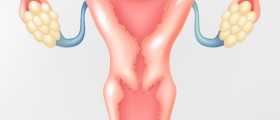
Period followed by the pains and cramps is called Dysmenorrhea. In most women menstruation does not cause major problems and does not disturb their general condition. But, there are women with a period accompanied with severe pain in the lower part of the abdomen or pelvis. Pain may be so strong that the woman is unable to do any activity.
Causes
Dysmenorrhea is not a disease but it can be a symptom of a disease, which sometimes cannot be detected. There are primary and secondary dysmenorrhea. Primary dysmenorrhea is more common. In women who have this type of menstrual cramps it is not possible to determine any objective reason for their appearance. It is thought that this disorder is consequence of psychological factors. That's why psychotherapy is very useful for some women.Also, Primary Dysmenorrhea may occur due to sudden mucosa separation the uterus wall. After that, uterus tries to eject separated mucosa, causing contraction that leads to pain and cramps. In this case there is no enzyme that would lead to the gradual peeling of mucous membrane.
Usually, the first periods in girls are painless because they don't include ovulation. After a few years, appears painful periods. After some time, usually after a birth, painful menstruation stops spontaneously.
Primary dysmenorrhea may also be caused by increased sensitivity to pain, which occurs in less developed women suffering from anemia, diabetes, tuberculosis or some other serious illness.
Secondary dysmenorrhea is usually a consequence of disordered relation between estrogen and progesterone, which leads to increased uterus convulsions, causing severe pain.
Besides that, dysmenorrhea may be caused by inflammation, tumor or adhesions.
Also, cervical canal narrowing caused by less developed uterus, reclining uterus or surgery may cause painful menstrual cramps.
Endometriosis rarely occurs as a cause of menstrual pain.
For primary dysmenorrhea is characteristic that its causes can not be detected during the gynecological examination, while causes of secondary dysmenorrhea are visible.
Symptoms
The main symptom of dysmenorrhea is pain. The pain usually occurs as a cramp a few hours before the appearance of menstruation. The pain subsides with the bleeding and stops or continues during the first days or for all time.In addition to pain may be present headache, chills, nausea, vomiting and diarrhea. Some women are at period time mentally unstable, irritable or weepy.
Treatment
Primary dysmenorrhea is treated by analgesics, sedatives, spasmolytics and nonsteroidal antirheumatics. If these drugs are not efficient then applies hormone therapy which establishes cycles without ovulation, because they are painless. Hormone therapy is carried out for several months, after which is necessary to make a break.Relieving secondary dysmenorrhea assumes treating its cause. This means treating the inflammation, surgical removal of tumor, surgical spreading narrowed cervical canal, endometriosis surgery or surgical correction of an irregular uterus position.













-Why-Some-Women-Take-This-Type-Of-Progesterone-During-Early-Pregnancy_f_280x120.jpg)



Your thoughts on this
Loading...